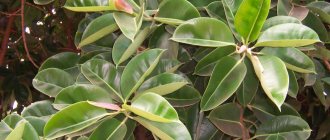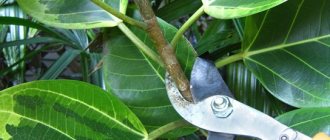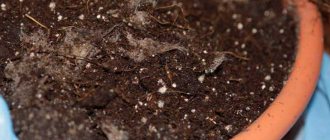Ficus is not only a beautiful decoration for any room, but also a lot of trouble associated with regular care of this plant, which loves to stretch upward and needs pruning from time to time. It is carried out in order to give the crown an optimal shape, but at the same time, as with any operation, it is very important not to cause harm. This article will tell lovers of indoor plants how to prune ficus so that it grows beautifully and continues to please the eye with its branches.
Is it possible or necessary to prune ficus?
Many newcomers to gardening or people who have not previously dealt with such procedures are interested in simple but quite logical questions, for example, is it possible to prune ficus benjamina? Many people really believe that it is impossible, complaining that the plant then dies. Such a course of events is not excluded, but it becomes relevant only when the pruning was carried out incorrectly, sloppily, or roughly. If everything is done carefully, then it will not in any way affect the further growth of the ficus, which, moreover, will even be happy with the modifications that are so necessary for it.
Thus, the myth about the harmfulness of pruning for a plant has been successfully destroyed, what about the immediate formation of the crown? Experienced gardeners believe that the best time of year for this business is spring, and they are largely right. It is at this time that the ficus is most prone to growth, the corresponding processes take place in it, and the microclimate, specifically for it, in the time period from March to April is very favorable. It would be a small mistake to form the crown later, but it is likely that it will turn out somewhat skewed, possibly asymmetrical.
This is if we talk about aesthetic nuances, but there are more important factors that directly affect the health of the ficus, which accumulates nutrients over time. To carry out pruning during this period means to deprive the plant of food, and therefore lead to its disease or, even worse, to death.
Important rules regarding pruning
Of course, you can cut all the branches in one fell swoop and consider that the task is completed. This will be partly true, however, in order for the flower to grow and grow in the future, everything must be done gradually.
Any formation of Ficus Benjamin begins no earlier than spring. This is necessary so that before the main growth, all the cuts have time to tighten well.
To carry out the manipulation, you will need to stock up on the following elements in advance:
- charcoal or activated carbon;
- manganese solution or alcohol;
- clean napkin;
- pruning shears
In order to prevent any infection from entering the plant, the pruning shears should be disinfected. This can be done using a manganese solution or alcohol. After which you need to move directly to the cutting itself.
Important! In order to form a ficus, you first need to get rid of excess branches.
As for thick branches, they are cut closer to the bud, at an angle. Young growth is trimmed right above the bud. Upon completion of the procedure, it is necessary to wipe off all the milky juice with a napkin, and rub the sections with activated or charcoal. None of the crown formation of Ficus Benjamin can begin without sanitary pruning, which will be discussed further.
General tips for circumcision
The first piece of advice is not to do everything under the notorious motto “maybe it’ll work out.” You need to know exactly how to trim a ficus and have confidence in your skills to approach such a meticulous procedure. During its implementation, the individual physiology of the plant should be taken into account. It is very important to understand that new shoots grow from apical and lateral buds. The latter are also called axillary, and this is exactly the moment when you can prune the ficus to grow in width. It is logical that removing the upper buds promotes the growth of the lateral ones, and vice versa.
As for the cut itself, it depends on the thickness of the stems, which can be thick or thinner. In the first case, you can cut at a slight angle, in the second, try to do it evenly. If a so-called wound appears and the plant secretes at least a little of its juice from the affected area, it’s okay - this is a natural process. The cut should be treated with a dry cloth and preferably sprinkled with wood charcoal.
Circumcision should not be done after a direct transplant of a ficus, for which a change of place of residence is already a huge stress, and under such circumstances it may not be able to withstand the loss of parts of itself. The age of the plant also matters. Young ficus trees tolerate this kind of intervention more easily, while old ones have more problems and are difficult to recover.
How to pinch correctly?
Ficus really doesn't like it when its location is changed. It can shed all its leaves at once. However, pinching does not cause serious stress if done correctly:
- Do not combine transplanting and pinching. Between one and the second procedure you need to take a break of 2 weeks.
- Use disinfected sharp tools - scissors, pruners, wire cutters. On young and soft shoots, the growing point can be plucked off with your fingers.
- Carry out the operation within the recommended time frame.
- Provide the plant with good care for quick recovery.
Age and timing
It is better not to miss the moment and start pinching the tree exactly when you need it to bifurcate. Otherwise, it will overgrow and the top will have to be cut off. After pruning woody shoots, stumps remain, and the buds on them are in no hurry to bloom.
With the help of pinching, predominantly young plants aged 1–3 years are formed.
The best time to pinch ficus is early spring. Around the end of February - March, plants wake up from hibernation and begin to form young shoots. By pinching out the growing points at this time, you are more likely to get strong side shoots. But the operation can be carried out later – until the onset of winter.
In the winter months, it is undesirable to engage in the formation of ficus: it is in a dormant state. In this case, pinching will not work or the shoots will grow painful and weak.
Step-by-step instruction
Before pinching the ficus, pay attention to the direction of growth of the topmost bud. The side shoot will develop in this direction.
There are several subtleties to pinching a green plant. To avoid mistakes and do everything correctly, use the instructions.
How to pinch a ficus step by step:
- Inspect the plant to make sure it is healthy and actively growing.
- Take the longest escape in your hands.
- Find the buds on it and see in which direction they grow.
- If the direction of the topmost bud suits you (it forms a side shoot), remove the part of the plant that is higher.
It is more convenient to pinch with a tool. But if the sprout to be removed is soft and thin, you can pinch it with your fingers.
Don't leave a long stump. The shoot is pinched immediately above the bud.
Ficus wounds are not treated with anything. The plant secretes a milk resembling dandelion juice, which promotes rapid healing of damaged tissue. To stop the liquid from oozing, wipe the pinched area with a damp cloth.
Ficus juice is poisonous and caustic. It is important not to allow it to come into contact with skin, mucous membranes, clothing or furniture. By placing a cut sprout on the table, you risk getting a stain that cannot be washed off with anything.
Further care
For rapid recovery, the plant needs good lighting and maintaining a temperature of +25 to +27 degrees. It also needs to be watered and sprayed regularly. Humidity should be high, but not excessive.
A month after formation, the ficus needs to be fed with liquid mineral fertilizer for decorative foliage plants or another nitrogen fertilizer.
At first, the internodes on the side shoots will be short and the leaves will be small. There is no need to worry about this. Gradually the internodes will stretch out. True, the lower leaves will remain small. This is the norm. Subsequent leaves will grow to a standard size.
Trimming ficus correctly at home
To carry out such a delicate procedure successfully and without harming the plant is worth a lot, so understanding how to properly prune a ficus at home is extremely important, especially for beginners in gardening. The first step is to start preparing the tools that will be the main characters in everything that happens next. You can take a knife or pruning shears, the main thing is that they are sharp. They must be thoroughly treated with alcohol for disinfection. Next, decide 100% what the crown will ultimately be:
- spherical;
- branched;
- another (optional).
This is if we are talking about decorative, anti-aging pruning, but there is also sanitary pruning, which consists in ridding the ficus of dead leaves and unnecessary shoots that interfere with it. By the way, it can be carried out at any time of the year, if such a need arises. The main thing is to prevent the infection from spreading from damaged leaves to young ones.
What is very important is that the stem cannot be made completely bald. At least five leaves should remain on it (if this is practically possible). You should use pruning shears at approximately a 20-30 cm distance from the main stem and try not to remove too young, fragile shoots. If during pruning you notice dry branches that are prone to wilting, then you should not hesitate to deal with them - remove them mercilessly. Here beauty fades into the background, initially - the health of the ficus.
Why pinch ficus?
Ficus is a genus of plants in the Mulberry family. They came to us from the tropics and subtropics. In their homeland they are considered parasitic plants. Ficus plants begin their lives as epiphytes, settling on other trees. Gradually, the “weed” entwines everything with its roots. Ultimately, the phorophyte on which it grows dies.
In indoor conditions, ficuses are not so active - they grow slowly and do not reach great heights. Only experienced gardeners manage to grow a spreading fluffy tree as tall as a man. Pinching helps partly with this. They are needed for the following purposes:
- to stimulate branching;
- to stop height growth;
- to maintain a given shape;
- for health and rejuvenation.
22
How to form a plant crown
Crown formation is a more creative process. If all the nuances of pruning are observed, if everything is done carefully and without harming the plant, then you can calmly focus on the aesthetic component. There are several types of crown formation:
- standard;
- round;
- asymmetric;
- at an angle.
The last three are pure gardener’s imagination and a matter of his taste, and the first, which also happens to be the most popular, requires adherence to some rules. Standard pruning is most often used. It is based on the formation of several tiers of stems at once. There may be 2-3 of them, or maybe 5 or even more, if we are talking about real giants living on the floor and the top almost touching the ceiling. The size of the plant directly determines at what height to trim the ficus. At the same time, it is important to maintain a certain distance between the tiers so that the result is visually attractive.
There is another, very ornate, but noteworthy way of forming a crown, when several plants are planted in one pot and then compared, thus creating a spectacular mix of different varieties. Considering the many varieties of ficus, the following methods are used:
- weave;
- launching in an arc;
- topping.
Any of these methods requires a lot of patience and attention to your pet. It should be remembered that the ficus grows as much as it can grow, and it is absurd to demand more from it.
Features of the formation of different ficuses
Pinching is an auxiliary, gentle method of plant formation. In the case of ficuses, it is impossible to get by with pinching alone.
To give the ficus a beautiful decorative look, it is regularly “cut”. In the spring, dry branches are pruned, as well as branches that have begun to grow in the wrong place.
In fact, ficus can be given any shape:
- bush;
- standard;
- bonsai;
- tiered;
- fence;
- spiral;
- free (wood).
A tree with interlacing at the bottom looks very beautiful. To do this, several young plants are planted in one pot, the side branches are cut off, intertwined and fixed. Soon they grow together.
To form a ficus, it is not necessary to use diagrams. You can give free rein to your imagination. The main thing is to remember three rules:
- The barrel must be strong enough.
- Side branches should not tilt the plant.
- Excessive branching is also bad.
First of all, the ficus must be stable and well lit. If you get carried away with pinching, you risk getting a plant with a thickened crown, suffering from a lack of light and air. This may result in leaf fall or fungal disease.
Ficus benjamina
The most popular representative of the genus. In nature, it grows up to 20 m in height, forms numerous aerial roots, which create additional support and form a multi-stemmed banyan tree. The leaves of the plant are leathery, shiny, and have short petioles. Variegated forms of Ficus Benjamin are often found. They need bright lighting to show their vibrant colors.
In the first 4 years, the plant develops rapidly. It is characterized by independent branching. However, the branches grow in a chaotic manner, quickly overgrow and bend.
Ficus Benjamin is often “trimmed”. Pinching is carried out to maintain the given shape of the bush.
Formation of the trunk (trunk)
With the help of proper pruning, you can give a beautiful look to the ficus trunk.
To form a trunk, you need to select a young specimen with a firmly rooted strong straight trunk, cut off all new side branches from it, leaving only 5-6 top ones. Repeat the procedure until the tree reaches the required height.
When the ficus reaches the desired size, you need to pinch the top, which will stimulate the growth and development of lateral branches.
By regularly pinching the top shoots and removing all the leaves at the base of the shoot, it is possible to obtain an adult ficus with a wide spreading crown and an emphasis on the trunk.
Further care
Beginner flower growers ask how to make the ficus bush actively.
After pinching the crown, it is very important to provide proper care for the plant.
First of all, it will need to be fed about a month after removing the branches. Replanting won't hurt either - this is another effective way to get side shoots to develop. For those whose home ficus has already acquired an impressive size, this need can be a real problem.
That is why, if desired, simply update the desired composition of the soil without removing the indoor flower from the pot. Knowing what to do to make the ficus bush, you can eventually get a branched plant. Pinch the ficus, taking into account the basic rules and recommendations of specialists, and get the awakening of the buds and the active development of the branches.
How to direct the branches in the right direction?
If you are growing a young Ficus Benjamin, the formation of the crown will require not only the timely removal of apical buds, but also pruning of the side shoots. It happens that pruning greatly exposes the crown of the tree, then it is better to refuse it. It's easier to point the branch in the right direction. Stiff wire is suitable for this purpose. It is wrapped around the protruding process and bent in the desired direction.
If the branches inside the crown cross each other unattractively, you can straighten them by using a wooden spacer.
What does ficus bonsai symbolize?
The fact that one tree was grown to its intended form over several generations was a symbol of continuity and tradition. In addition, bonsai shows the three periods of life that every living creature goes through: the beauty and freshness of youth, the beauty of maturity, and the wisdom of old age.
Interesting materials:
How to select several photos at once in iCloud? How to choose arrows in Assassin's Creed Odyssey? How to choose freeze-dried coffee? How to choose fresh peonies? How to choose fresh oyster mushrooms? How to choose a pork neck for barbecue? How to choose your Emoji VK status? How to choose a topic for your book? How to choose thermal underwear for running? How to choose thermal paste for your computer?
Creating unusual shapes
There are many options for creating interesting ficus shapes. Flower growers are attracted to forms in the form of a spiral or a fence; someone may be interested in a braided braid. To do this, plant the sprouts in strict sequence. The result of painstaking work will delight you with unusual beauty if you use the right preparation scheme.
Beautiful braid
Sanitary pruning
As for sanitary pruning, it is carried out as needed. It is advisable to carry out the procedure in early spring, but if dry, underdeveloped or diseased branches appear on the plant, then you should not wait for the right moment. Not everyone knows, but such shoots can become a cause that will lead to the occurrence of various fungal infections. Some people are afraid to trim branches that are not needed, although there is nothing wrong with that. Such unnecessary shoots lead to an increase in the density of the crown, which does not allow light to pass inside.
Formation of the crown and general appearance
The beautiful appearance and fluffiness of the crown are formed in the process of regular painstaking work. The shape of the apical part of the flower is planned in advance. You need to determine how tall the ficus will be. It is important to understand right away whether it will be a standard plant or a fluffy bush. The owner of the flower himself decides how to form the ficus.
When there are too many internal shoots, the crown can be thinned out. They leave buds that are directed not along the trunk, but outward. If the task is to form a round crown, leave an equal number of branches directed horizontally and vertically. The shoots are pruned in a circle, at an equal distance from the point marked in the center.
Formation of the plant crown includes:
- pruning of apical shoots;
- shortening side branches;
- direction of the processes in a certain direction.
Bending and fixing is done using wire, ropes, and pegs. Branches growing in the wrong direction are aligned and secured with tension devices. It is not always necessary to cut off healthy strong shoots at the root. It is better to give them the desired shape. There is no guarantee that the new branches will grow evenly and strong enough.
You can give the desired direction if you bend the branch away from the central trunk; just secure it at the required distance using a spacer or slingshot.
Note! To avoid damaging the bark, foam rubber, cotton wool, or fabric are placed under the tip of the stick.
The crown formed in the form of a ball or cone looks beautiful. The apical part of the ficus can be cut in the form of any geometric figure. Several shoots form a single intertwined trunk with a common crown. Such a tree will decorate an office or home winter garden.
To form a trunk, all shoots are pruned, except for the five apical ones. When the ficus has grown to the desired height, pinch the central stem, then shorten all the branches that have grown beyond measure in a circle. Such manipulations are possible only with young plants.
How to rejuvenate an adult specimen?
A beautiful large tree has lost its leaves and dried up? Don't rush to throw it away. Understand the reasons for this behavior. If the reason is a long dry period or the influence of low temperatures, then the tree can be saved. It is necessary to provide him with optimal temperature conditions and good living conditions. Cut off all dried branches at the root. Or remove all the growth altogether so that young growth grows in its place. The plant will be able to recover due to its developed root system.
However, this method will not work if it is the roots that are initially damaged. And it was because of their illness that the leaves fell.
For experiments, it is better to choose a young ficus Benjamin. Forming the crown of adult specimens is more difficult. They do not grow green mass so quickly. There is no question at all about intertwining thick trunks or splicing them.
How to grow ficus benjamina correctly?
Lush branches of the plant begin to form after the top shoot is removed. Ficus benjamina should be pinched when the plant is healthy and full of vigor. It is better to form a crown before reaching the age of three, while it is actively growing. After this time, it is more difficult to give the desired shape, and the restoration process will become a little more complicated. How to pinch ficus benjamina? To do this you need:
- Prepare the plant for the procedure - wash it in the shower and water it.
- Stock up on the necessary tools, water, a clean rag and activated carbon.
- It is recommended to cut thin branches straight, thick branches - obliquely.
- After trimming, the white juice is removed with a wet cloth and the cut is sprinkled with activated carbon.
- When pruning, keep an eye on the shape of the plant so that it has a pleasant, natural appearance.
- Branches that spoil the appearance, grow parallel to the main trunk, intertwine and greatly thicken the ficus must be removed.
- The top and side shoots are shortened to give them the pre-planned shape.
Regular pruning is one of the components of ficus care and is necessary not only for the beauty, but also for the health of the tree.











